Affiliate disclosure: This post may contain affiliate links. Please see our Privacy Policy.
Canning Asian pears are a bit different than putting up European pear varieties.
While European pears are high acid fruits with soft flesh, Asian pears are crisp low acid fruits that need added lemon juice for safe canning.
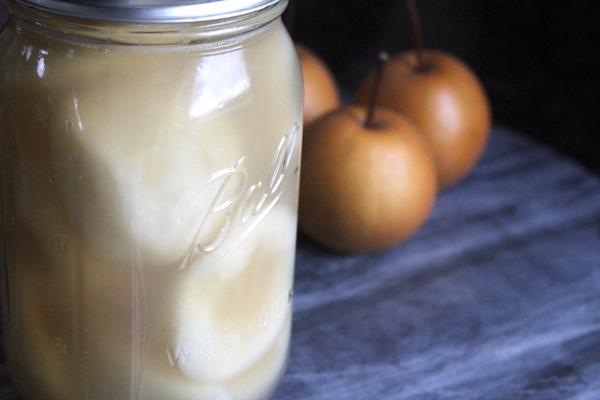
Table of Contents
Right out of college I was working at a non-profit that specialized in agriculture advocacy, and I found myself tabling at an expo on local food. The woman next to me was from a local orchard, and she was handing out samples of locally grown Asian pears (no small feat of work here in our harsh climate in Vermont).
The weather that day turned bad, and turnout was much less than expected…which meant she had several cases of Asian pears left when the event ended.
She offered them to me, and I eagerly accepted…but now I had a problem.
Asian pears don’t keep well, and though I ate all I could manage on the long drive home, I still had quite the haul to preserve.
Some quick googling and I learned, much to my dismay, that Asian pears are not quite acidic enough to safely can on their own.
At that point in time, around 2008, the conventional wisdom was that you could not can Asian pears because there was no tested recipe approved by the national center for food preservation. A decade before that they had been considered just fine for canning, alongside regular pears.
In 2015, the Oregon State Extension tested a recipe for canning Asian pears and concluded that they are in fact safe for water bath canning, so long as you add 1 tablespoon of lemon juice per pint or 2 tablespoons per quart.
It’s interesting how canning regulations seem to go back and forth, with best practices shifting from one decade to the next. It’s not just with pears. Mangoes, for example, used to be approved for home canning.
The Ball Complete Book of Home Preserving (2006) includes a recipe for canning mangoes, but now the conventional wisdom is that they’re unsafe for canning. Since they’re only just barely low acid, I imagine in a few years that will be reversed again, as new tested recipes come out, likely involving the addition of just a bit of lemon juice similar to canning Asian pears.
Just one more reason to always check a few sources when you’re looking for a canning recipe, so you have the most up to date information available.
How to Can Asian Pears
The first step to canning Asian pears is peeling and coring.
They peel easy enough with a sharp paring knife, and I’ve found the best way to remove the core is to use a small metal teaspoon measuring spoon (or melon baller). That pulls out all the hard internal core portion in the center, leaving more fruit than coring with a knife.
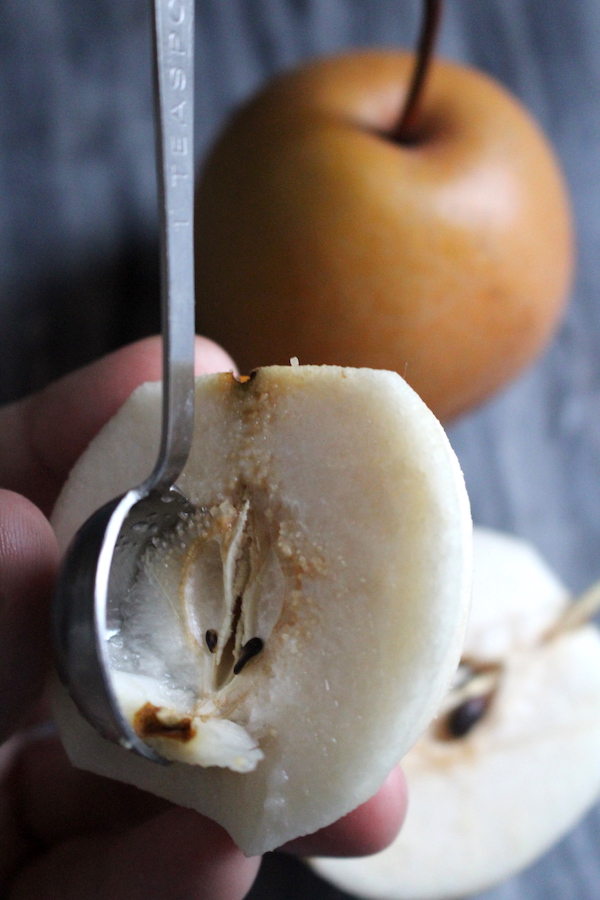
Asian pears tend to brown very quickly, faster than just about any other fruit I’ve canned. It’s important to get them treated with lemon juice quickly, just as soon as you get the core out.
I peel them and core them one at a time, getting each pear half into a bowl of water with a bit of lemon juice added just as soon as the core is removed.
Once they’re peeled and cored, you have two options for canning. Asian pears can be raw packed into jars as they are, or they can be hot packed.
Raw packing means you can work with the pears more easily to fit them into the jar, but it has consequences for quality. Raw packed Asian pears don’t store as well, will float in the jar and will discolor over time.
They also don’t work well for canning without sugar (if that’s your preference.)
For a raw pack, simply pack the peeled and cored Asian pears into either quart or pint canning jars, leaving 1-inch headspace.
Hot pack store much better and maintain better quality, but you have to pack them into jars hot, which can be tough on the fingers.
I’ve found that using the long end of a wooden spoon into the jar helps position them, and then I can pack the Asian pears into canning jars efficiently without burning my hands.
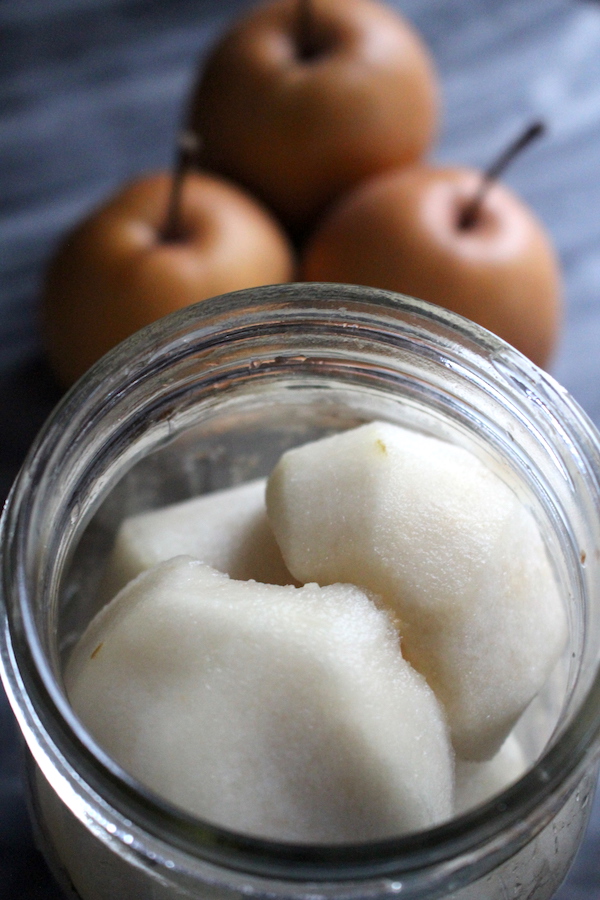
For hot pack, bring the Asian pear pieces to a boil in a pan along with your canning liquid. This can be water, juice or syrup (extra light to medium). Cook the pear pieces for about 5 minutes, so they’re still firm but hot all the way through.
Strain the pears out of the juice and hot pack them into prepared canning jars, leaving 1-inch headspace.
Regardless of whether you’re raw packing or hot packing, canning in juice, water or syrup, you need to add lemon juice to acidify the canning liquid for safe canning.
Adding lemon juice is not optional, though it does have the added side effect of helping maintain flavor during canning.
Add 1 tablespoon lemon juice to each pint canning jar, and 2 tablespoons for a quart jar.
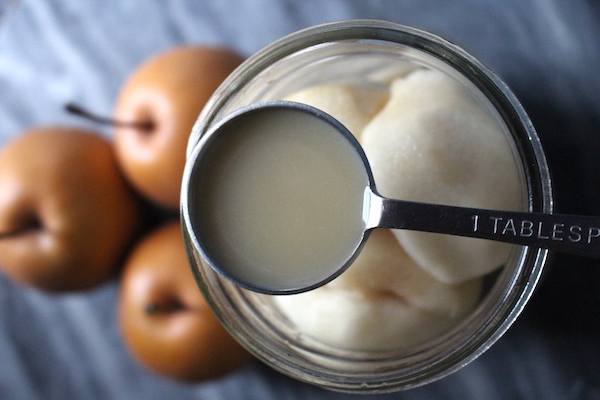
For both raw and hot pack, once you’ve added lemon juice to each jar, it’s time to pour boiling canning liquid into the jars to fill.
The canning liquid is completely up to you, and they can be packed in plain water, juice (apple or pear) or syrup of your choice. I generally use extra light syrup because it roughly approximates the natural sweetness of the fruit.
For a guide on sugar to water ratios, here’s a table with quantities of sugar to make various strengths of canning syrups, from extra light to extra heavy syrup.
Pour the hot syrup into the jars, leaving 1/2 inch headspace. (Note: You left 1 inch of headspace above the whole pear chunks, but now you’re filling with canning liquid and leaving only 1/2 inch headspace.)
Remove air bubbles, adjust headspace, wipe rims and process the jars in a prepared water bath canner for 20 minutes for pints or 25 minutes for quarts.
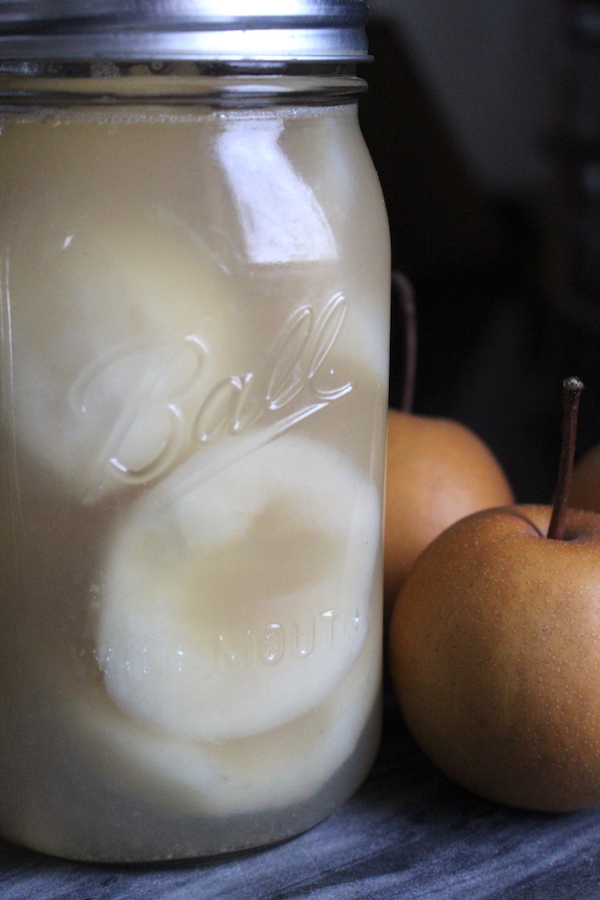
Once the Asian pears are canned, they can be used in much the same way as any canned pears. The trick is, they’ll have their own flavor of course, but they’ll also stay firmer in baked goods.
I really love using canned Asian pear halves to make a version of this NY Times Plum Torte. The pears work out really wonderfully in place of the plums.
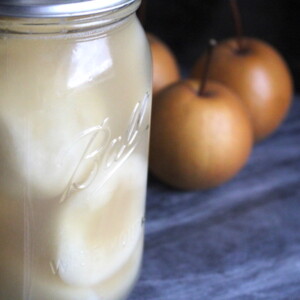
Canning Asian Pears
Ingredients
- Asian Pears
- Canning Liquid, Water, Syrup or Juice
- Lemon Juice, 1 Tbsp per Pint
Instructions
- Prepare a water bath canner and canning jars (pints or quarts).
- Peel and core pears, and slice or leave as pear halves. Put the pear pieces into water with a bit of lemon juice to prevent browning.
- Prepare canning liquid of your choice (water, apple juice, pear juice, white grape juice or sugar syrup). Bring the pear pieces to a boil in the canning liquid and cook for 5 minutes.
- Hot pack the pear pieces into canning jars leaving 1 inch headspace, and add 1 tablespoon lemon juice to pints (or 2 tbsp for quart jars).
- Pour boiling canning liquid over the top of the pears, this time leaving only 1/2 inch headspace.
- De-bubble jars, adjust headspace, wipe rims, apply 2 part canning lids and process in a water bath canner. (20 minutes for pints, and 25 minutes for quarts).
Notes
More Canning Recipes
Looking for more fall canning recipes? Here are a few to keep you going:
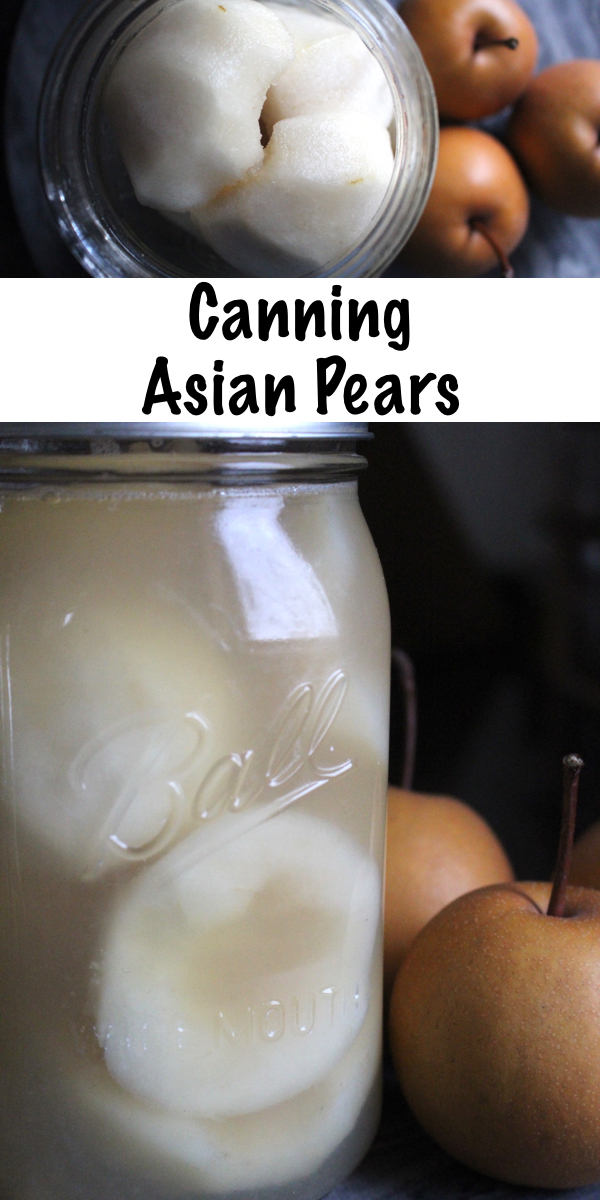
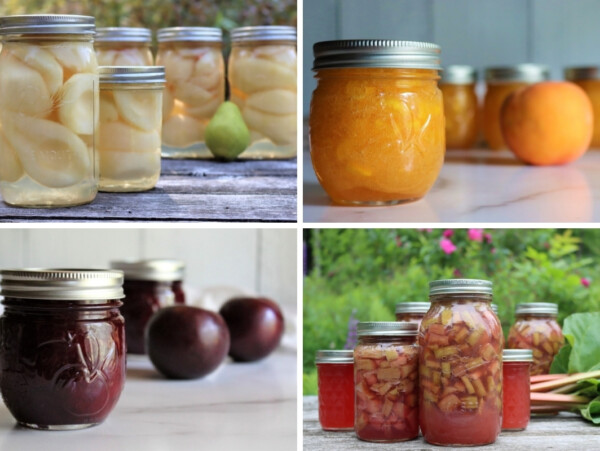
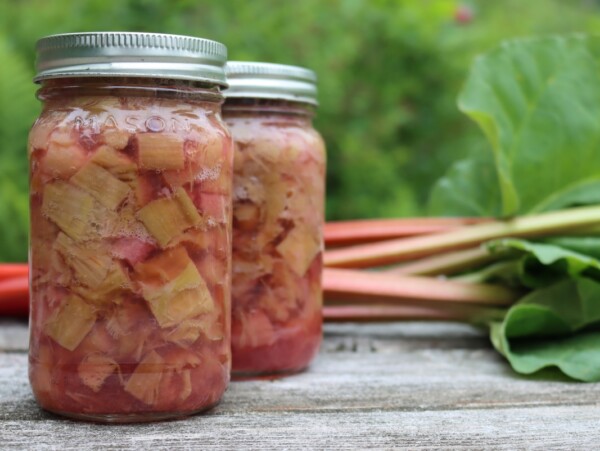
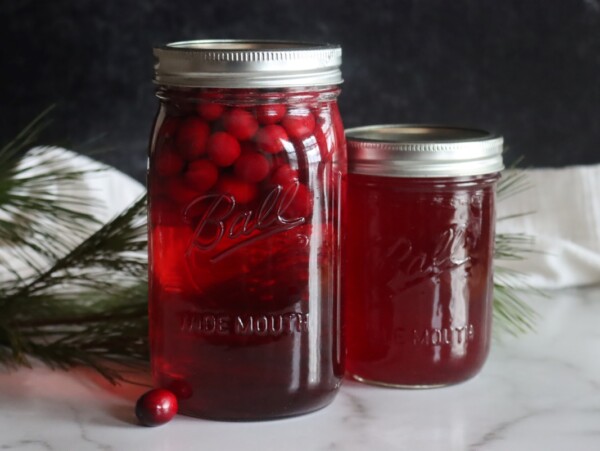
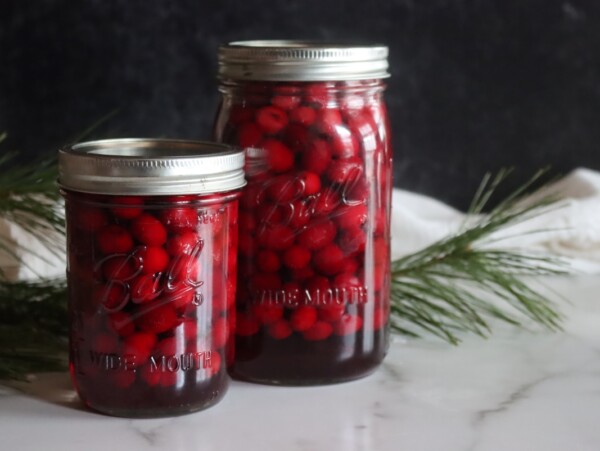
I found that lime juice complements the flavor of Asian pears.
That sounds delicious!
I just realized I only did 1 teaspoon per jar not a tablespoon of lemon juice. Do you think my pears will still be ok?
They will not have enough acid in them to be considered safe. Depending on how many you have, you may want to transfer them to the fridge and consume fairly soon.
I am going to try making “spirited pears” That’s what the Ball canning book calls pears flavored with a little alcohol.
I am thinking I will add Fireball to my lite syrup. When I bring it to a boil the alcohol will cook out . I think. Hopefully this will have a nice cinnamon spice flavor. I will add the lemon juice to the jars. A red color would be nice too. I also grow pomegranates. I might add a little pom juice to the syrup too. Wish me luck. Bonnie in California
Hi would it be possible to use citric acid instead of lemon juice, as this would not change the flavour
Yes, you can use citric acid in place of lemon juice. One tablespoon of bottled lemon juice is equal to 1/4 teaspoon citric acid.
I just recieved “A LOT” of Asain pears. I was hoping to can some pear pie filling with them. Do you have any suggestions on how to do this safely. Could I add extra lemon juice to the recipe ? My current recipe calls for 24c. of sliced pears and 3/4 c. of lemon juice. And the other ingredients. Thank you ,
There is no tested method for canning asian pear pie filling. That said, if I were going to do it, I’d add more lemon juice to the instructions for canning pear pie filling. When canning pear pie filling, you use the recipe for “peach pie filling” and substitute pears. Here’s that recipe: https://practicalselfreliance.com/canning-peach-pie-filling/
It calls for 1 3/4 cups lemon juice for 7 quarts of finished pie filling. With asian pears, you’re supposed to add 1 tbsp lemon juice to each quart. In this case, rounding up for an added safety margin, that’d be 2 1/4 cups lemon juice for a batch. (8 Tbsp is equal to 1/2 cup, and you’d need at least 7 Tbsp.).
That method makes sense to me….but again, it’s not tested, so you’ll have to use your own best judgement here.
And…that’s a LOT of lemon juice in a batch. It might just be too lemon-y to be tasty.
Cinnamon Sticks make a wonderful addition – and the pears are delectable!
I have 2weird questions for you. What is the difference between jam & jelly jars vs reg pint
canning jars ??? Thickness of glass ?? Also those cute pint jars with the handles, either one of these be used for canning fruit ??? Thank you ahead of time.
I am not aware of any canning jars that are available with handles. I know they sell drinking glasses that look like a mason jar with a handle. You just want to be sure that your jars are manufactured specifically for canning. There really is no difference between the jelly jars and other canning jars. Both can be used interchangeably.
Why do I need to peel the Asian pears before canning? Much work!
Most people choose to peel the pears to avoid a grainy texture but it is perfectly ok to leave them on if you wish.
I found the CANNING ASIAN PEARS recipe to be well referenced and easy to follow. Here are some added tips and tweaks that I hope others find useful. I wanted to can six quarts and started with a bushel of pears.
My water bath pot can hold six quart jars. So filled the jars with water, placed in the pot. Filled the pot with water above the rim of the jars, Set to boil.
In another large pot that the pears would cook in, I added four quarts water, 1 cup lime juice (same as bottled lemon juice), and one cup raw sugar.
Sadly, our pear trees have stony pit, which is not bad to eat, just not pleasant. Rather than halve the pears as Ashly did, I peel with a vegetable peeler top to bottom. When there is a stony pit spot, I leave a wedge of skin on. With an apple slicer the pears are cut. Wedges with the skin still on go in the peel pile. The good wedges go into a four cup pitcher until full. Then into the pot with juice water. Six times.
Since the pears are cut into wedges, I reduced full rolling boil time to 3 minutes. Just sitting in the hot pot, the pears would continue to cook.
With the boiling hot jars on one side of a table. A large shallow cake pan in the middle to catch drips. With the cooked pears on the other side, I was ready to pack. Using a one cup commercial ladle with holes, the pears were packed into the jars with a canning funnel. Same, one inch below the rim.
Using a glass two cup pitcher, a pour over coffee funnel and #4 paper filters, the jars were filled with juice to ½” of the rim. The filter is effective at removing sediment from the juice. After filling two jars the filter needed to be replaced. Screw on the lids and back into the still hot water bath. Fair warning, the bath water pot is very heavy. Back on the stove for 25 minutes.
A few remaining slices served as a taste test. Wonderful. Six pings from the jars made me happy that the pack is good.
I canned 6 quarts of Asian pears yesterday and just ran across the requirement to add lemon juice to the jars in order to raise the acidity. I did soak the pears in lemon juice (1 pt per gal of water) to help maintain color when I was prepping the pears. They soaked for about 15 or 20 minutes. Will this soaking raise the acidity enough to make the pears safe for eating?
I personally would not feel comfortable with this since the lemon juice was so diluted with the water and much of it probably stayed in the water as opposed to going directly into the jar.
How much lemon juice do I add to the water I put the pears into as I peel them?
You can use roughly 1/2 cup of lemon juice per gallon of water.
I was very disappointed with the last Asian pears that I canned. I added the lemon juice as the recipe suggested but could taste it in the finished product and didn’t like it. I did some with ascorbic acid instead of lemon juice and didn’t like that taste either. Any suggestions?
You’re stuck with some form of acidification with Asian pears unfortunately, and likely you’ll be able to taste it all to some extent.
What’s the proper method for pressure canning with this recipe? Usually if it’s 20 minutes hot water bath it’s like 10 minutes at 6lbs of pressure, but if you know, I’d like to be certain!
You know, I honestly don’t know since I’ve only ever done them in a water bath. I did a bit of research online and couldn’t find a good answer. If I were to do it in a pressure canner, I’d do it at 5 lbs in my weighted gauge for the full 20 minutes process time just out of an abundance of caution, but that’s just a guess and I honestly don’t know.
Thanks for the info – I just moved into a home with 19 fruit trees & have quite a few Asian pears I need to figure out what’s to do with. I had heard they weren’t good for canning & I appreciate the info so I can use them safely!! 🙂
What luck! Asian pear trees are so lovely, congrats on your new home orchard =)
Does it have to be bottled lemon juice, or can it be fresh?
Bottled lemon juice is at a standard acidity, which is why it’s generally used for canning. Lemons vary slightly, from pH 2.0 to 2.7 I believe. I’m not sure what bottled lemon juice is standardized at, but that’s why canning recipes are always tested using bottled. If you do choose to use fresh, I’d suggest using more than the recipe calls for as a safety precaution.
Also know that without the bottled lemon juice it’s not a “tested” recipe.